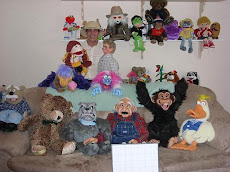The death of British comedian Ray Alan recalls a lost age when ventriloquists were cosy family entertainment favourites. Today, they are more likely to be found at the cutting edge of subversive alternative comedy.
Go on, try it. Try saying something - "bottle of beer," even - without moving your lips.
Now imagine keeping 30 million TV viewers entertained at the same time.
Once ventriloquism was not just a party trick or a kitsch throwback. It was a major branch of showbusiness.
The passing of Ray Alan - a ventriloquist of rare technical accomplishment - is a reminder of how far from public favour this branch of stagecraft has fallen. With his sidekick puppet Lord Charles, Alan became a prime-time favourite in a more innocent era.
It's a sort of licensed Tourette's
Nina Conti
Ventriloquist
In the 1950s and 60s there were thought to be some 400 full-time ventriloquists working in the UK - but by the early 2000s this had dwindled to just 15, according to estimates by Professor Steven Connor of Birkbeck University.
But if the act now calls to mind working men's clubs and end-of-pier shows, or nostalgia clip show staples like Roger de Courcey (and Nookie Bear) and Terry Hall (with Lenny the Lion), its latest incarnation is very different.
Nowadays the biggest names in ventriloquism include Americans like the brash, politically incorrect Jeff Dunham and David Strassman, whose Chuck Wood puppet makes Eric Cartman from South Park sound like Larry the Lamb.
The shift in the craft's centre of gravity is symbolised by America's Got Talent winner Terry Fator, an all-round entertainer and singer whose ventriloquism act nonetheless plays with taboos surrounding race and sex.
All have achieved this by tapping into the latent weirdness of the form - let's face it, those puppets are creepy - and refashioning them with an edgy, punk rock sensibility.
One ventriloquist - or, as those in the know would put it, "vent" - who has been at the forefront of this new wave is Nina Conti, whose sweetly-spoken onstage persona is thrown into darkly comic relief by her puerile, foul-mouthed monkey puppet Monk.
Even Keith Harris has updated his act to keep up with the new ventriloquists
Now an award-winning staple of Britain's comedy clubs, Rada-trained Conti turned to ventriloquism when her acting career initially failed to take off.
Initially she dismissed the craft as a throwback to a bygone era, but quickly discovered its subversive potential - and has been working on a documentary, Her Master's Voice, which explores its subversive roots.
"It's a sort of licensed Tourette's," she says. "I'm shocked by what the puppet can get away with - things I could never say to someone in a million years.
"I started this thinking one day I wanted to give it up eventually. But then I realised that there are really no limits to what you can do with it."
Still, Conti's street credibility is far removed from the previous generation of British vents who suddenly found that their work had become unfashionable.
Usually recruited from the working men's circuit or even, if they were old enough, music hall, they suffered from television's move away from traditional variety formats.
One victim of the shift in attitudes was Keith Harris, whose partnership with Orville the duck and Cuddles the monkey had made him a major star before he was dropped from the airwaves as the 1990s dawned.
"All of a sudden we didn't get the chance to be on TV any more," he complains, still audibly bruised. "Running things you had these new, young guys from universities who thought they knew what people wanted."
Whoever was to blame, it still was a long way from the days when the act was so popular that vents like Edgar Bergen and Peter Brough could, bizarrely, deliver their routines on radio to general acceptance.
But perhaps, all along, it was the unthreatening, mainstream entertainers who were out of step with ventriloquism's traditions.
Ray Alan and Lord Charles were more subversive than their image suggested
Dr Helen Davies, a lecturer at Leeds Metropolitan University who has studied the subject, believes there was always a darkness to ventriloquism during its peak years, which ran from the late-19th to mid-20th Century.
"The subversive properties are all there," she says.
"It stems from this idea of mimicry and parody and the idea of the dummy talking back, as well as the inanimate becoming animate - it's all about a transgression of boundaries."
In this respect, she says, the most successful modern vents have cannily tapped into the legacy of dummy-themed horror films like 1964's Devil Doll and 1978's Magic, which starred Anthony Hopkins as a deranged ventriloquist.
And, indeed, even the most popular vents of the television variety era appeared to realise this.
Ray Alan may have presented an unthreatening, cardigan-wearing charm, but Lord Charles's drunken, lecherous persona allowed for comedy based around sex, class and alcoholism.
"I dreamed the other day that I was giving a speech at the House of Lords, and d'y'know, when I woke up, I was," ran a typical Lord Charles routine - predating the anarchic, anti-establishment puppetry of Spitting Image by decades.
And even Keith Harris - whose career apotheosis came with Orville's rendition of the sickly ballad I Wish I Could Fly - has moved with the times, offering an adults-only version of his act in which Cuddles turns the air blue.
"Maybe with the Americans coming over - they're a bit more straight-talking," he adds. "But there's nothing new in ventriloquism. The basic gags they do, like leaving the puppet onstage on its own, are ones I was doing 35 years ago.
"It's just about bringing it up to date."
Perhaps, all along, ventriloquism has been about telling the audience to talk to the hand.
Subscribe to:
Post Comments (Atom)








No comments:
Post a Comment